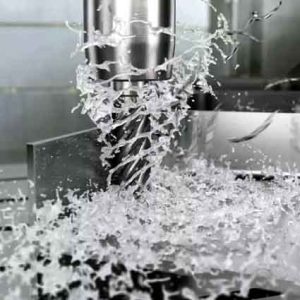フライス加工中, チタン合金の重要な特性は、熱伝導率が非常に低いことです。. チタン合金材料の高強度と低い熱伝導率により、, 非常に高い切削熱 (制御されていない場合は最大 1200°C) 処理中に生成される. 切りくずと一緒に熱を放出したり、ワークに熱を吸収したりしません。, しかしCNCの最先端に集中しています. このような高熱は工具寿命を大幅に短縮します.
Using special CNC processing technology, it is possible to improve the performance and life of the tool (using the correct CNC processing technology to control the temperature, the temperature can be reduced to 250 ~ 300 ℃).

チタン合金部品の CNC 高速フライス加工
1. Reduce heat generation in titanium milling
Reducing the radial and axial engagement between the tool and the titanium workpiece can control the generation of cutting heat. For titanium alloys, the adjustment period for speed, 送り速度, and radial and axial joints is very short before a built-up edge is generated due to overheating. In order to achieve proper tool life, the maximum “joining arc length” の 15% is required for machining titanium alloys, compared with 50% に 100% when machining ordinary steel. Reducing the contact arc length can increase the cutting speed and increase the removal rate of titanium without losing the life of the tool.
Using a cutting tool with an angle of 45° or thinning titanium chips can increase the contact length between the cutting edge of the tool and the chips. This reduces local high temperatures, extends the life of the cutting edge, and also allows higher cutting speeds.
2, Geometrical design of blades for cutting titanium
チタン合金を製粉するとき, the use of peripheral grinding inserts is essential to minimize the cutting pressure and friction with the machined surface. The geometric angle of the milling insert must be positive, but this is not enough to ensure optimal performance. If in order to strengthen the first part of the cutting edge, a small initial angle with higher strength is used. Then the use of a larger secondary angle (to obtain a larger front chamfer) is the best geometric design for enhancing the compression resistance of the milling insert and prolonging the tool life. 加えて, slight passivation also helps to protect the cutting edge, but the size of the passivation must be coordinated with the cutting process and maintain tight tolerances. When machining titanium requires the use of sharp cutting edges cut the material, but too sharp cutting edge is prone to chipping and shorten tool life. Proper passivation can protect the cutting edge and avoid premature chipping. The correct blade geometry parameters can reduce the stress and pressure on the tool material, make the tool longer life and improve processing efficiency.
The cutting angle of the milling cutter body and the insert must be a positive angle to obtain a progressive cutting effect, and to avoid impact on the entire cutting edge during cutting and failing to obtain the desired milling effect. If this is not done, the structure of the workpiece may be deformed, making processing impossible.

チタンキャビティ加工とスパイラル補間加工
3. Cavity milling and spiral interpolation milling of titanium parts
When performing titanium pocket milling and spiral interpolation milling, internally cooled milling tools must be used. If possible, a constant pressure coolant should be used, which is especially important for deep cavity or deep hole machining.
When processing deep cavities, the use of high-density cemented carbide extension tools with modular cutting heads can increase rigidity and reduce flexural deformation to obtain the best processing results.
The function of the coolant is to remove the chips from the cutting area and avoid secondary cutting that may cause early tool failure. 同時に, the coolant also helps to reduce the temperature of the cutting edge, reduce the geometric deformation of the workpiece, and extend the life of the tool.
Spiral interpolation milling holes with milling cutters can reduce the use of other tools (such as drills, 等) in the tool magazine. A milling cutter of one diameter can be used to machine holes of different sizes.
As the application of titanium alloys in the aerospace industry continues to grow, the cutting technology that supports high-efficiency CNC machining of titanium alloys is also constantly evolving. Due to the large demand for the processing capacity of titanium alloy parts, those workshops or manufacturers that use the most effective processing technology will benefit first.
 English
English العربية
العربية 中文(漢字)
中文(漢字) Čeština
Čeština Dansk
Dansk Nederlands
Nederlands Suomi
Suomi Français
Français Deutsch
Deutsch Italiano
Italiano 日本語
日本語 ಕನ್ನಡ
ಕನ್ನಡ 한국어
한국어 Português
Português Русский
Русский Slovenčina
Slovenčina Español
Español Svenska
Svenska Türkçe
Türkçe

